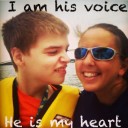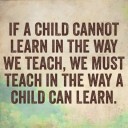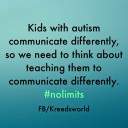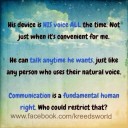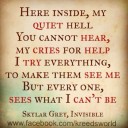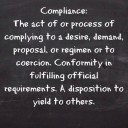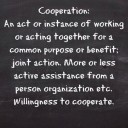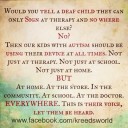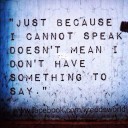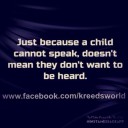Kreed’s World: A Complex Journey Through Autism
By dinamk on March 16, 2015 in Informative Blogs with No Comments
ABA and AAC
By: Erin Polk -
Kreed’s World: A Complex Journey Through Autism
About: Kreed is 16 years old and is nonverbal- meaning he cannot use his natural voice to speak. Kreed is diagnosed with autism as well as a number of medical issues: hypothyroidism, epilepsy, SCAD (metabolic disorder), Adrenal Insufficiency (his adrenal system does not work and produce cortisol), CVID- an immune deficiency. He also suffers from a number of food intolerance’s which renders him gluten, soy, dairy free, as well as other foods….read more…
This is not about DTT. This is not about PRT. This is not about NET etc etc etc. Or any other three letters that are a “subtype” of Applied Behavior Analysis (ABA). This is about using the principles of ABA all day, every day to help a teenager with autism learn to communicate with his Alternative and Augmentative Communication (AAC) device. Over the years so many “types” of ABA have cropped up- each proclaiming to be new and improved version. Or a mix of DTT with naturalist teaching instructions. Or whatever someone wants to say it is. I have a news flash for all of those people- it’s ALL ABA. Period. If you knew ABA inside and out, you would realize that the point of ABA is so that children learn naturally. If you are good at ABA- that should be your goal in the first place! When anyone decides one one “type” of ABA, you are then possibly only using “part” of ABA, and thus you can’t just assume you can only use part of ABA with every child you meet and expect it to work for every child. Meaning some children might need some version of discrete trial, but in other situations more natural examples. It’s different for all kids and across skills. Rarely does a child need one and only one approach while they learn.
Augmentative and alternative communication (AAC) is all forms of communication (other than your own natural voice) that are used to communicate everything (needs, wants, thoughts, comments, responses, questions etc). In people with severe language delays or a lack of functional speech or any kind of speech, AAC devices are used to become their voice. These can include Sign Language (so those peeps who think they are not using AAC by teaching sign language- this is AAC too), picture exchange systems, switches, eye gaze or computer devices that use symbols or words. The thing to understand about AAC devices is that it enhances speech AND impacts behavior. If an individual is able to communicate, they won’t have to rely on maladaptive behaviors to get their point across- hence why ABA practitioners should be all over this! I’ve learned over the years the lack of use of AAC devices through the years has more to do with experience, or lack thereof, and limited knowledge of how to implement devices to impact people’s behaviors. This is why we film Kreed, this is why I write about it and why I try to advocate far and wide for the use of communication devices by families- not just speech therapists in a session- but for children, teens and adults to have a voice at all times, even if it is not their natural one. One more added fact about AAC devices. For those who believe that using an AAC device will cause a child to NOT speak, check out the research first. Research has shown that in fact, using AAC device ONLY helps develop even more oral communication (Blischak, Lombardino, & Dyson, 2003, Miler et al., 2006). ABA is a science and we only use scientifically researched approaches- the proof on how AAC devices can be implemented and help behavior and speech is right there in the research literature. For any ABA practitioner that says using AAC will halt any kind of oral speech or impede progress in using their natural speech- you are giving false information and perhaps limiting an individual’s progress by not knowing the research. Shame on ABA practitioners who do this because you are also not disseminating correct research and telling families the exact opposite of what sound scientific research has shown.
At home with Kreed you will see us use ABA all the time, all day, in every situation. Just like his use of his AAC device. The reason we are successful with his AAC device is because we use the principles of Applied Behavior Analysis to teach him the language of the device. We MODEL language for him, we PROMPT him to use the correct language, and we REINFORCE his correct use of his device. We reinforce this mainly by either respecting the words he says, by delivering the item he chose with his communication, by or engaging in conversation.
With every behavior Kreed exhibits, we try to determine the function (which is just a fancy way to say we figure out why he’s behaving the way he is- is it a want/need, sensory, attention, escape/avoidance or automatic?). Once we know that, we generally replace it with language to help him navigate the situation. For instance- his current obsessive issues. While most would think it’s x, y or z, for Kreed it’s actually a medical reason causing his obsessiveness. In reaction to not getting his obsession he tends to bite himself. So we block his biting attempts and then give him new language. We are response blocking and replacing the behavior with language. ABA at its core.
We are also consistent. Once we give Kreed an answer- that’s it. Even when he argues to death on his device. But that’s the wonderful thing- we replace his behavior with words on his device. We constantly redirect him to using his device. Because guess what? If he’s pressing buttons on his device and arguing, that behavior is incompatible with biting or hitting his head on something. And we praise him highly for using his device. So in ABA speak we are doing a DRI- differential reinforcement of incompatible behavior. We are reinforcing the use of his device which he uses his hands for- and he does not use his hands to bite, since they are busy talking to us.
We also have clear goals for Kreed. We don’t work on everything at once or everyone would be crazy with it. We normally target a few activities for Kreed to be successful with at a time, work on them until he masters them, and then move on. For instance, right now we are working increasing his attention to tasks with playing games. Kreed’s skills have grown by leaps and bounds and he is finally at the point where he is ready to learn new games rather than just movies. So we are using a token economy system (the tokens are actual cash haha- can’t get more natural of a reinforcer than that) and as he completes and activity or a chore at home, he earns a dollar. When he gets to five dollars, he gets to go to Five Guys or choose to save it for something else. Currently he needs many verbal and physical prompts to complete activities. It’s mastered for us when he can complete the activities without assistance to completion. Again ABA at its finest. His secondary goal to the activities is using activity based language on his device. We don’t just play games with Kreed and expect him to silently interact and just complete them and be done with it. Our actual point is to increase his language on his AAC device. So we always add vocabulary specific to his games or chores when the time come and then first we MODEL the language we expect him to say depending on the situation, then we PROMPT him to use the language. This is how it works for most situations, we model and then we prompt and then over time we gradually reduce the prompt until he is commenting on his own. ABA and AAC working together hand in hand, just as it should be.
This is also why I don’t understand why more behavior analysts don’t embrace AAC technology, why more speech therapists and behavior analysts don’t work together. Our job is to impact the children’s behavior, to turn the maladaptive to appropriate behavior and to either develop new skills or improve current skills. All of this can be done with AAC. We have the technology NOW. Yet not everyone uses it for these kids who are nonverbal- particularly older kids with autism or adults where the technology was not available at the time of early intervention. Why should I ever expect a child to just “comply” with whatever it is I want to do, without the individual having a choice in the matter? Just because they are nonverbal, does not mean they don’t want to be heard. It does not mean they don’t have feelings and thoughts going on in their head. As a result of being unable to speak with their natural voice, they are the unheard voices in our communities. They are the students and clients just expected to do as they are told and when they refuse, they are labeled as non-compliant. I have a newsflash to people who label individuals who are nonverbal non-compliant: refusing to do activities is the ONLY voice they have. It is the ONLY way they are able to assert choice. Without language, they are left in this chaotic world with the choice to follow what everyone tells them to do, or refuse to do it and face the consequences.
Kreed was labeled non-compliant for years and years. He never had a voice or a choice. Now when you hear him “talk,” it’s amazing to watch the wheels turn in his head and the things he thinks of, just to have a voice, just to have a choice. Choice in life is a fundamental human right, it’s not an action only for those that use their natural voice to speak. We should be working much harder to give children, teens and adults a voice. Much harder. Kreed’s case alone has taught me this and countless others. I welcome my arguments with Kreed because it means he has a voice and he is using it. It means he does not have to do exactly what we say (well, if I say no, it’s still no ha, but he can at least try to negotiate a better position), but he has room to negotiate and to try to improve his life on his own and not rely on others 100% of the time.
And speaking of non-compliance: Practitioners need to get rid of the archaic language based on the word compliance. It should be COOPERATION not COMPLIANCE. I refuse to have individuals comply, I want them to cooperate. Cooperate denotes that we are working together to goals. Compliance denotes a power struggle and a power hierarchy that says I have more say than you and you have not right to any other choice. It is this kind of language that leads individuals who are nonverbal to continue to not have a voice.
There is such a vast language difference between the two words.
In Compliance it even mentions the words “conformity” and “coercion.” That’s awfully powerful language to be using on kids and once again highlights the magnitude of the word.
But this word:
Denotes a more positive word and more descriptive to what we are actually trying to accomplish with these kids! If we were to use cooperation over compliance, it would improve our teaching abilities because we will be attempting to learn to teach better so that the children we are working with will cooperate with the task at hand. It also allows for dialogue rather than strict obedience. Aren’t we trying to get the children to have joint attention and joint actions! Our goal should be COOPERATION not COMPLIANCE. Period.
This is also where the marriage of ABA and AAC falls apart. To be successful in implementing an AAC device, the foundation has to be cooperation not compliance. The device is THEIR voice. I don’t have a right to tell them exactly how to use it or refuse to accept their words. Just as I would never silence an individual who uses their natural voice, I would never silence and individual who needs a device to communicate. That means for every meltdown, tantrum, every learning opportunity or any other time- that device needs to be present. ABA could be the basis for teaching so many to have a voice using AAC and from a young age. I would rather have a child learn to talk back to me during a session with a device, then just sitting there waiting for what is next, but not being able to help decide or have a say in anything.
We impacted Kreed’s behavior by using AAC. When we used to tell him he couldn’t go to five guys (if he brought us the picture card, or anything that looked like checkers because that’s what the walls there look like), it would be the end of the world. Biting, hitting, yelling, and throwing himself on the ground. He couldn’t cooperate with us. He couldn’t negotiate. Now with his device, we might say no, and he might then ask us a thousand more ways (Five guys is my favorite restaurant. Are we going to five guys? I love it.. I love French fries. Can we go? Among others ha), and the answer may still be no so then we give him more choices, “We can’t go to five guys right now, do you want to do…” and then he can make more of a choice or decide to talk to us more etc. The fact of the matter is, he is TALKING to us, rather than getting angry. Or he is talking to us while he is angry but he’s not hurting himself. As a result of being able to talk through his frustrations, his behaviors have lessened significantly. And we didn’t have to come up with fancy charts, or various reinforcement systems or timers or any other more complicated procedures than just teaching him to communicate to us on an AAC device.
Prior to becoming conversational on his device, where he could only say wants and needs but still lacked back and forth language, this was also his behavior if he just brought us a picture of what he wanted:
https://www.youtube.com/watch?v=L48pMhkaDtA
With the RIGHT device and implementing his device in all situations:
https://www.youtube.com/watch?v=jtf3CHpB-Ks
This blog is both about how ABA can be used successfully with individuals who use AAC, but it’s also about a call to arms for individuals who are nonverbal. Realizing it should be about cooperation and not blind obedience. Ensuring that they should be allowed a voice and a choice in life, just as those who have their natural voice are afforded that ability anytime they want to voice it.
For videos to see ABA and AAC in action please visit Kreed’s Face Book, Blog or YouTube.
More posts on ABA and AAC will follow including Assessment and using verbal behavior principles to help AAC language!
For more research on AAC and the impact it has on communication and language, check out this list from PRAACTICAL AAC:
Ganz, J.B., Earles-Vollrath, T.L., Heath, A.K., Parker, R.I., Rispoli, M.J., & Duran, J.B. (2012). A meta-analysis of single case research studies on aided augmentative andResearch Reviews Supporting the Use of AAC alternative communication systems with individuals with autism spectrum disorders. Journal of Autism and Developmental Disorders, 42,1, 60-74.
McCarthy, J., & Light, J. (2005). Attitudes toward individuals who use AAC: Research review. Augmentative and Alternative Communication, 21(1), 41-55.
Millar, D. C., Light, J. C., & Schlosser, R. W. (2006). The impact of AAC intervention on the speech production of individuals with developmental disabilities: A research review. Journal of Speech, Language, and Hearing Research , 49(2), 248-264.
Schlosser, R. W., & Blischak, D. M. (2001). Is there a role for speech output in interventions for persons with autism? A review. Focus on Autism and Other Developmental Disabilities, 16(3), 170-178.
Schlosser, R. W., & Sigafoos, J. (2006). Augmentative and alternative communication interventions for persons with developmental disabilities: Narrative review of comparative single-subject experimental studies. Research in Developmental Disabilities, 27(1), 1-29.
Schlosser, R. W., & Wendt, O. (2008). Effects of Augmentative and Alternative communication intervention on speech production in children with autism: A systematic review. American Journal of Speech-Language Pathology, 17(3), 212-230.
Tien, K.C. (2008). Effectiveness of the Picture Exchange Communication System as a functional communication intervention for individuals with autism spectrum disorders: A practice-based research synthesis. Education and Training in Developmental Disabilities, 43(1), 61-76.
Facebook Feed
Featured App
Sentence Builder - Kindergarten, First Grade, Second Grade
A fun new sentence builder app to learn about words, sentences, pronunciation, grammar, and punctuation.
The ONLY sentences app that can be fully customized with your own pictures, words and sentences.
We worked closely with teachers, parents and kids to design and test this app.
Read more
Latest App
Physical Science for Second Grade
![]()
- The ONLY app that allows the users to CREATE their own stories, questions and add their own images.
- The ONLY app that READS the stories, comprehension questions and choices.
Reading Comprehension Physical Science for Second Grade has twenty stories about the physical science related young children's daily life. You can also create and add your own stories to the app.
Read more
© Copyright 2025. All rights reserved. Powered by AbiTalk.


